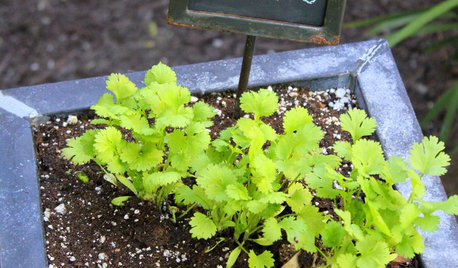How do I make coriander from Cilantro plant?
tussiemussies
18 years ago
Related Stories

GARDENING GUIDESHerb Garden Essentials: Versatile Cilantro Adds Flavor to Herb Gardens
Love it or hate it, this cool-season herb contributes its unique flavor to any number or the world’s cuisines
Full Story
CONTAINER GARDENS8 Easy Container Plants to Grow From Seed
Get beautiful blooms and herbs in summer by starting these choice garden picks from seed in spring
Full Story
SALVAGEReinvent It: Make a Cheery Planter From an Old Eyesore
Don't ignore that yucky old grill growing rust in your yard — turn it into a lighthearted planter that's a joy to see
Full Story
DECORATING GUIDESAn Expat’s Guide to Making a Home Away From Home
How do you stay balanced when each foot is in a different culture? You take a stand where you hang your hat
Full Story
FEEL-GOOD HOMEWhat Really Makes Us Happy at Home? Find Out From a New Houzz Survey
Great design has a powerful impact on our happiness in our homes. So do good cooking smells, family conversations and, yes, big-screen TVs
Full Story
MOVINGMaking a Home Away From Home
Feeling like a stranger in a strange land? These tips can help ease the transition after a big move
Full Story
ROOM OF THE DAYRoom of the Day: Making Over a Harlem Living Room From 3,000 Miles Away
Using photos, video and email, San Francisco designer Jacqueline Palmer created a stylish living room for a New York City entrepreneur
Full Story
HOUZZ TVHouzz TV: How to Make and Plant a Veggie Box
See how to start edibles from seed, then transfer the seedlings to a box on stilts to make harvesting more fun
Full Story
FUN HOUZZEverything I Need to Know About Decorating I Learned from Downton Abbey
Mind your manors with these 10 decorating tips from the PBS series, returning on January 5
Full Story
FEEL-GOOD HOME12 Very Useful Things I've Learned From Designers
These simple ideas can make life at home more efficient and enjoyable
Full StoryMore Discussions










garnetmoth
herbalbetty
Related Professionals
Salisbury Landscape Architects & Landscape Designers · Signal Hill Landscape Architects & Landscape Designers · Goodyear Landscape Contractors · Medford Landscape Contractors · Mooresville Landscape Contractors · Arden-Arcade Landscape Contractors · Athens Landscape Contractors · Byram Landscape Contractors · Cockeysville Landscape Contractors · Deerfield Landscape Contractors · Lynchburg Landscape Contractors · Thonotosassa Landscape Contractors · University City Landscape Contractors · Chicago Ridge Landscape Contractors · Cheshire Gardeners & Lawn CaretussiemussiesOriginal Author
ltcollins1949
shortarse_hedgewitch
ltcollins1949
dgbeig
ltcollins1949
Daisyduckworth
garnetmoth
nygardener
flowersandthings
tussiemussiesOriginal Author
breezyb
noinwi
shortarse_hedgewitch
chaman
flora_uk